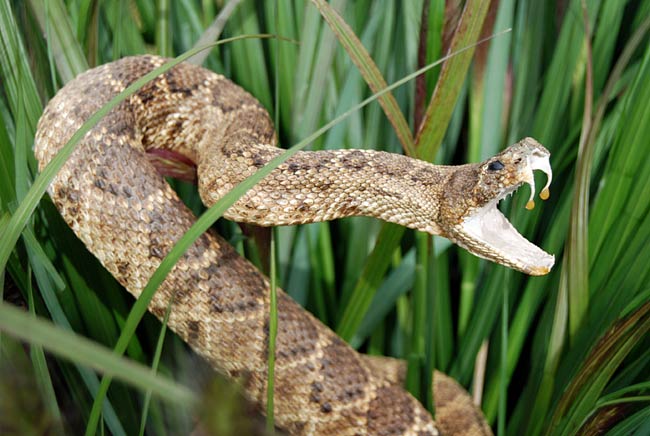How Snakes Got Their Fangs

Biologists have sunk their teeth into the question of snake fang development, revealing how these poison prickers have evolved from regular teeth and allowed snakes to become such champion biters.
The research suggests that both rear and front fangs in venomous snakes developed from separate teeth-forming tissue at the rear of the mouth — unlike the situation for non-venomous snake dentition and human teeth. This finding, detailed in the July 31 issue of the journal Nature, could explain why snakes flourished beginning some 60 million years ago, geologically soon after non-avian dinosaurs went extinct.
"The snake venom system is one of the most advanced bioweapon systems in the natural world," said lead researcher Freek Vonk of Leiden University in the Netherlands. "There is not a comparable structure as advanced, as sophisticated, as for example a rattlesnake fang and venom gland."
Fang factors
Snake fangs are sharp, enlarged teeth positioned along the upper jaw at the front or rear of a snake's mouth and connected to venom glands. Only the venomous snakes, which are considered advanced snakes, sport such fangs, while the non-venomous snakes like pythons are equipped with only the normal rows of teeth.
And sometimes even a venomous snake will impart a "dry" bite, not delivering the potent venom.
Most venomous snakes, including grass snakes, have fangs positioned in the rear of the mouth, while a few groups, including rattlesnakes, cobras and vipers, have fangs jutting down from their upper jaws in the front of the mouth.
Sign up for the Live Science daily newsletter now
Get the world’s most fascinating discoveries delivered straight to your inbox.
"If you want to eat a very dangerous prey, like a big rat with razor-sharp rat teeth, then it would be more advantageous to have your fangs in front of the mouth so you can just bite it quickly and then let go," Vonk told LiveScience, "instead of biting it and holding on and then chewing the venom into the tissue, because then the rat can bite back.
Fang development
To figure out how both types of snake fangs evolved from non-fanged species, Vonk and his colleagues looked at fang development in 96 embryos from eight living snake species. Here are their names:
Non-venomous snakes:
- Water python (Liasis mackloti)
Venomous front-fanged snakes:
- Indonesia pit viper or Hageni’s treeviper (Trimeresurus hageni)
- Rhombic Night Adder (Causus rhombeatus)
- Malayan pit viper (Calloselasma rhodostoma)
- Asian spitting cobra (Naja siamensis)
- Cape Coral Snake (Aspidelaps lubricus infuscatus)
Rear-fanged venomous snakes:
- Rat snake (Elaphe obsolete)
- Grass snake (Natrix natrix)
The team's analyses showed that the front and rear fangs develop from a separate teeth-forming tissue at the back of the upper jaw. For all front-fanged venomous snake species, the front fangs displaced forward during embryo development by rapid growth of the embryonic upper jaws. The rear fangs stayed put where they formed.
That's unlike the dental development scenario for humans and non-venomous snakes, such as pythons. As an embryo, all of our teeth in the upper jaw sprout from one tooth-forming tissue, while all the bottom teeth develop from another tooth-forming tissue.
"The uncoupled rear part of the teeth-forming tissue evolved in close association with the venom gland, thereafter forming the fang-gland complex," Vonk said. "The uncoupling allowed this to happen, because the rear part of the teeth-forming tissue did not have constraints anymore from the front part."
Super snakes
The separate development of the rear part of the tissue, Vonk said, may have played a major role in snakes' ability to diverge into the 3,000 species found throughout the world today.
"It sheds light on one of those nagging questions in herpetology — how did a diversity of fang types among snakes evolve?" said David Kizirian, a herpetologist at the American Museum of Natural History in New York who was not involved in the study.
The research was funded by the Netherlands Organization for Scientific Research, Dutch government, Dutch Technology Foundation, Curatoren fund, LUSTRA fund, Australian Research Council, Australian Academy of Science, Whitman College and Leiden University Fund.
- Top 10 Deadliest Animals
- Image Gallery: Snakes of the World
- Can Snakes Smell, Hear, See?
Jeanna Bryner is managing editor of Scientific American. Previously she was editor in chief of Live Science and, prior to that, an editor at Scholastic's Science World magazine. Bryner has an English degree from Salisbury University, a master's degree in biogeochemistry and environmental sciences from the University of Maryland and a graduate science journalism degree from New York University. She has worked as a biologist in Florida, where she monitored wetlands and did field surveys for endangered species, including the gorgeous Florida Scrub Jay. She also received an ocean sciences journalism fellowship from the Woods Hole Oceanographic Institution. She is a firm believer that science is for everyone and that just about everything can be viewed through the lens of science.










